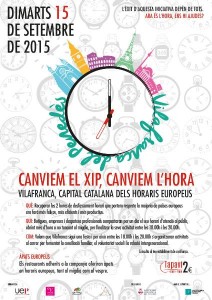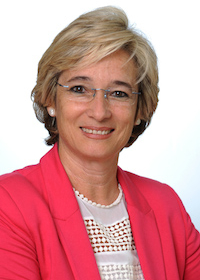Nuevo curso, nuevos horarios de trabajo… ¿Para qué?
 Esta semana se ha producido la vuelta al cole y la reincorporación al trabajo tras las vacaciones de verano de la mayoría de personas en el hemisferio norte.
Esta semana se ha producido la vuelta al cole y la reincorporación al trabajo tras las vacaciones de verano de la mayoría de personas en el hemisferio norte.
Para muchos entrar en la rutina laboral después del periodo de vacaciones les produce el llamado “síndrome post-vacacional”, cierto desánimo y falta de motivación.
Para superar este síndrome ya lo recordaba Victor Frankl en su libro El hombre en busca de sentido: “el que tiene un porqué para vivir puede soportar cualquier cómo”….hay que preguntarse por la motivación última del trabajo… ¿Para qué trabajamos?
 Este verano leí este estupendo artículo de Juan Manuel de Prada (link) sobre el sentido del trabajo. El título nos recuerda que “El hombre ha nacido para trabajar como el ave para volar”. El hombre (la persona humana) no trabaja para satisfacer sus necesidades básicas, ni para allegar ahorros, ni para prosperar socialmente (aunque sea legítimo que a través de su trabajo alcance tales logros), sino para ser hombre, para reconocerse como tal, para alcanzar la realización plena de su humanidad, su perfeccionamiento personal.
Este verano leí este estupendo artículo de Juan Manuel de Prada (link) sobre el sentido del trabajo. El título nos recuerda que “El hombre ha nacido para trabajar como el ave para volar”. El hombre (la persona humana) no trabaja para satisfacer sus necesidades básicas, ni para allegar ahorros, ni para prosperar socialmente (aunque sea legítimo que a través de su trabajo alcance tales logros), sino para ser hombre, para reconocerse como tal, para alcanzar la realización plena de su humanidad, su perfeccionamiento personal.
 Esta consideración del trabajo como actividad que deriva de la dignidad humana, se fue difuminando con la introducción del trabajo asalariado, con la supeditación del trabajo al capital, convirtiéndose en medio y no algo valioso en sí mismo y con unas leyes que debilitan y desprotegen a los trabajadores, sin respeto al bien común, la justicia social, y a la dignidad de la persona. En este error siguen anclados muchos líderes políticos y empresariales, una concepción mecanicista, en la que el hombre es un mero recurso, una máquina. Toda reforma fundada en este paradigma fracasará, porque el hombre así tratado siente aversión al trabajo y desapego con su empresa, lo que repercute en su motivación y productividad.
Esta consideración del trabajo como actividad que deriva de la dignidad humana, se fue difuminando con la introducción del trabajo asalariado, con la supeditación del trabajo al capital, convirtiéndose en medio y no algo valioso en sí mismo y con unas leyes que debilitan y desprotegen a los trabajadores, sin respeto al bien común, la justicia social, y a la dignidad de la persona. En este error siguen anclados muchos líderes políticos y empresariales, una concepción mecanicista, en la que el hombre es un mero recurso, una máquina. Toda reforma fundada en este paradigma fracasará, porque el hombre así tratado siente aversión al trabajo y desapego con su empresa, lo que repercute en su motivación y productividad.
 El hombre necesita amar y sentirse vinculado a lo que hace; en esta necesidad de ligazón o vínculo se resume el sentido de nuestra vida, presente y futura. Nada existe en el mundo de forma aislada o independiente: necesitamos ligarnos a otras personas, necesitamos vivir unos por otros y para otros; y necesitamos ligarnos al trabajo que sale de nuestras manos y verlo con orgullo y amor sereno. El trabajo es ese vuelo a través del cual expresamos y desarrollamos nuestra humanidad. Sólo con esta visión del trabajo se le enciende el sentido y vuelve a él con ilusión renovada tras las merecidas vacaciones.
El hombre necesita amar y sentirse vinculado a lo que hace; en esta necesidad de ligazón o vínculo se resume el sentido de nuestra vida, presente y futura. Nada existe en el mundo de forma aislada o independiente: necesitamos ligarnos a otras personas, necesitamos vivir unos por otros y para otros; y necesitamos ligarnos al trabajo que sale de nuestras manos y verlo con orgullo y amor sereno. El trabajo es ese vuelo a través del cual expresamos y desarrollamos nuestra humanidad. Sólo con esta visión del trabajo se le enciende el sentido y vuelve a él con ilusión renovada tras las merecidas vacaciones.
 La Reforma Horaria catalana apoyada por el Parlamento catalán y el Govern para el 2016, ayuda a resituar el Trabajo como valor en sí mismo, devolviéndolo al justo medio, es decir, facilitando la conciliación de la vida laboral, personal y familiar. Esta semana la Ciudad de Vilafranca (link) ha sido nombrada la capital catalana de la reforma horaria, ya que ha sido la primera ciudad en experimentar por un día los horarios europeos en los comercios, liberando horas para la vida social, familiar y personal.
La Reforma Horaria catalana apoyada por el Parlamento catalán y el Govern para el 2016, ayuda a resituar el Trabajo como valor en sí mismo, devolviéndolo al justo medio, es decir, facilitando la conciliación de la vida laboral, personal y familiar. Esta semana la Ciudad de Vilafranca (link) ha sido nombrada la capital catalana de la reforma horaria, ya que ha sido la primera ciudad en experimentar por un día los horarios europeos en los comercios, liberando horas para la vida social, familiar y personal.
¡¡A ver cuál será la siguiente!!
Seguimos…




Nuria, como siempre, tu blog lleno de buenas noticias. Leo con gran satisfacción que va calando hondo la idea de saber conciliar trabajo y familia. ¡Enhorabuena por la buena siembra que haces!!!
Hola. Feliz inicio de semana. Desde esta noche fecha dominical aquí en Centro América. Mil gracias por el interesante texto sobre el nuevo horario y otros. Veo que la ecología humana, sobre la que insiste el santo padre Francisco, va tomando forma en principios como estos expuestos por el IESE. Felicitaciones. Deseo recordarles, por otra parte, que el fundador de California ( y abuelo del Valle del Silicón) es fray Junípero Serra, a quien el mismo papa argentino va a canonizar en estos días en los Estados Unidos. Yo creo que Uds. están bien cerca de la cuna de Junípero, y pueden averiguar cosas que nosotros desde aqui no captamos. Cordial saludo.
Buen concepto Nuria y elaboracion pero me parece que hemos llegado tambien a la hora de hablar de el genero humano y no de » hombre «.
Uno de los mayores progresos realizados en los ultimos anos por la ONU, OECD y otras instituciones es el de incluir en todos los textos el nombre de genero y no de masculino .
Old school versus what is happening and evolving in the world to have women participating in the work force .
I have done some interesting work about the role of womenin the labour force and gender economics that i will be pleased to share with IESE .
A debt of gratitude for a time when I visited Navarre and » borroed some thoughts for my international marketing courses at Western Sydney University .
Please take this comments in the light given ie. advamcement and empowerment of gender economics . Saludos
Querida Nuria, siempre es un placer leer tus artículos, me encanta saber que la idea de conciliar horarios para trabajar y poder atender a nuestra familia como se merecen, va calando poco a poco en nuestra sociedad, para mí eso es síntoma de evolución y creo tu labor, trabajo y dedicación, ayuda mucho. Así que muchas gracias!.
HAVE A DAY.
Nuestra Señora Reina de los Ángeles Asistencia
From Wikipedia, the free encyclopedia
This article is about the mission in Los Angeles, California. For the one in Pecos, Mexico, see Mission Nuestra Señora de los Ángeles de Porciúncula de los Pecos.
Nuestra Señora Reina de los Angeles Asistencia Nuestra Señora Reina de los Angeles Asistencia
«Los Angeles Plaza» circa 1847. The «Plaza Church»
(foreground, seen from the rear) occupies what remains of the
Mission San Gabriel Arcángel asistencia site.
Nuestra Señora Reina de los Angeles Asistencia is located in Los Angeles Metropolitan Area
Nuestra Señora Reina de los Angeles Asistencia
Location of Nuestra Señora Reina de los Angeles Asistencia in Los Angeles
Location Los Angeles, California
Coordinates 34°03′26″N 118°14′23″WCoordinates: 34°03′26″N 118°14′23″W
Name as founded Asistencia de la Misión San Gabriel, Arcángel [1]
English translation Sub-Mission of the Mission San Gabriel Arcángel
Founding date 1784 [1]
Military district First
Native tribe(s)
Spanish name(s) Tongva
Gabrieliño
Native place name(s) Yaanga [2]
Current use Nonextant
Nuestra Señora Reina de los Ángeles Asistencia was originally founded in early 1784 within the burgeoning Pueblo de Los Ángeles as an asistencia (or «sub-mission») to the nearby Mission San Gabriel Arcángel.[3] The assistant mission fell into disuse over time and a Catholic chapel, La Iglesia de Nuestra Señora Reina de los Ángeles, was constructed in its place a mere thirty years later.
History
Asistencia de la Misión San Gabriel, Arcángel
In the first months of 1784, priests from San Gabriel established an assistant mission in the neighboring Pueblo de Los Angeles along the banks of El Rio de Nuestra Señora La Reina de Los Ángeles de Porciúncula, in an area with a high concentration of potential converts. At a half-a-day’s ride to the east, the mother mission was too distant to serve the area effectively. Father Presidente Junípero Serra had the opportunity to visit the asistencia on March 18, 1784, just five months before his untimely death. Perhaps more important than its duty to provide religious instruction to the local natives was the settlement’s role in growing crops and grazing livestock to feed the inhabitants of Mission San Gabriel, whose padres divided their time between that outpost and the new site.[4] The abundant water supply allowed for the planting of citrus orchards and raising of cattle in abundant numbers.
In time, however, the priests abandoned the site as the pueblo grew in population and the native poblanos moved away (few of the nuevos cristianos were welcomed in the pueblo). Relatively little of the site’s physical record remains today.
La Iglesia de Nuestra Señora Reina de los Ángeles
Main article: La Iglesia de Nuestra Señora Reina de los Angeles
On August 18, 1814 Fray Luis Gíl y Taboada placed the cornerstone of a new church amidst the ruins of the former asistencia to serve the local pobladores (settlers); the completed structure was dedicated on December 8, 1822.[1] The padres of San Gabriel donated 7 barrels of brandy to help establish the new chapel.[5] A replacement chapel, named for Mary, Mother of Jesus (La Iglesia de Nuestra Señora de los Angeles, or «The Church of Our Lady of the Angels») was rebuilt utilizing materials of the original church in 1861; Reina, meaning «Queen,» was added later.[6] For years the little chapel, which collected the nicknames «La Placita» and «Plaza Church,» served as the sole Roman Catholic church in Los Angeles. The Plaza area today is popularly known as Olvera Street.
Notes
Wikimedia Commons has media related to Nuestra Señora Reina de los Angeles Asistencia.
Ruscin, p. 49.
Ruscin, p. 195.
California Mission Studies Association.
Harley.
Krell, p. 125.
Ruscin, p. 50.
References
«Directory for Missions and other Hispanic Sites». California Mission Studies Association. Archived from the original on April 2, 2007. Retrieved May 30, 2007.
Jones, Terry L. and Kathryn A. Klar (eds.) (2007). California Prehistory: Colonization, Culture, and Complexity. Altimira Press, Landham, MD. ISBN 0-7591-0872-2.
Krell, Dorothy (ed.) (1979). The California Missions. Sunset Books, Menlo Park, CA. ISBN 0-376-05172-8.
Paddison, Joshua (ed.) (1999). A World Transformed: Firsthand Accounts of California Before the Gold Rush. Heyday Books, Berkeley, CA. ISBN 1-890771-13-9.
Ruscin, Terry (1999). Mission Memoirs. Sunbelt Publications, San Diego, CA. ISBN 0-932653-30-8.
«The San Bernardino Asistencias by R. Bruce Harley». California Mission Studies Association. Archived from the original on June 13, 2006. Retrieved November 21, 2006.
POBRE HORTELANO DE MALLORCA LLEGA A LA PUEBLA DE NUESTRA SEÑORA REINA DE LOS ÁNGELES:Pueblo de Los Ángeles
From Wikipedia, the free encyclopedia
See also History of Los Angeles, California
La Plaza, as seen from the Pico House, c.1869. The «Old Plaza Church» is to the left, the brick reservoir on the right, in the center of the plaza, was the original terminus of the Zanja Madre.
El Pueblo de Nuestra Señora la Reina de los Ángeles (the Town of Our Lady the Queen of the Angels) was the Spanish civilian pueblo founded in 1781, which by the 20th century became the American metropolis of Los Angeles.
Official settlements in Alta California were of three types: presidio (military), mission (religious) and pueblo (civil). The Pueblo de los Ángeles was the second pueblo (town) created during the Spanish colonization of California (the first was San Jose, in 1777). El Pueblo de la Reina de los Ángeles—’The Town of the Queen of Angels'[1] was founded twelve years after the first presidio and mission, the Presidio of San Diego and the Mission San Diego de Alcalá (1769). The original settlement consisted of forty-four people in eleven families, recruited mostly from Sonora y Sinaloa Province. As new settlers arrived and soldiers retired to civilian life in Los Angeles, the town became the principal urban center of southern Alta California, whose social and economic life revolved around the raising of livestock on the expansive ranchos.
Founding
In 1542 Juan Rodríguez Cabrillo, with a commission from Viceroy Antonio de Mendoza, was the first European to sail along and explore the California coast. Although he claimed all he saw as territory of the Spanish Empire, no efforts at colonization were made for over two hundred years. Concerned about colonizing efforts by the Russians and French, Spain set plans in motion in the 1760s to establish a presence and defend its claim to the territory.
The Spanish settlement did not reach Alta California until 1769, when explorer Gaspar de Portolà reached the San Diego area via the first land route from Mexico. Accompanying him were two Franciscan Padres, Junípero Serra and Juan Crespí, who recorded the expedition. As they came through today’s Elysian Park, they were awed by a river that flowed from the northwest, past their point and on southward. Crespí named the river El Río de Nuestra Señora la Reina de los Ángeles de Porciúncula, meaning, in Spanish, «the River of Our Lady Queen of the Angels of Porciuncula».[2] The name derives from Santa Maria degli Angeli (Italian: «St. Mary of the Angels») is the name of the small town in Italy housing the Porciuncula, the church where St. Francis of Assisi, founder of the Franciscan order, carried out his religious life. The river that was called the Porciuncula is today’s Los Angeles River. Because the future town’s name was a take on this «Queen of Heaven» Marian title, various versions of Crespí’s formula would be used for the town, including the exceedingly long El Pueblo de Nuestra Señora Reina de los Ángeles sobre el Río Porciúncula.[3]
During the expedition, Father Crespí observed a location along the river that would be good for a settlement or mission. However in 1771, Father Serra instead commissioned two missionaries to establish the Mission San Gabriel Arcángel-San Gabriel Mission near the present day Whittier Narrows section of the San Gabriel River. The missionaries encountered resistance from the Tongva to their attempts to resettle the Natives on the mission. The mission encountered further trouble in 1776 when a flood damaged the mission, convincing the missionaries to move and rebuild the mission on a higher and more defensible location: its present site in San Gabriel. The first Spanish governor of Las Californias, Felipe de Neve had, as well, recommended to Viceroy Bucareli Father Crespí’s location on the Río Porciúncula (Los Angeles River) for a mission. Instead, in 1781, King Charles III mandated that a pueblo be built on the site instead, which would be the second town in Alta California, after San José de Guadalupe in 1777. The monarch, disregarding the production and trade roles of the missions, saw a greater need for secular pueblos to be established as the centers of agriculture and commerce to supply the crown’s ever-growing military presence in «Nueva California.» The priests at the missions ignored the royal mandate and continued their ranching, trading and production of tallow, soap, hides, and beef, often in competition with new pueblo ventures.
Settlement
See also: Los Angeles Pobladores
Governor de Neve took his assignment seriously and had a complete set of maps and plans drawn up by May 1780 for the layout and settlement of the new pueblo, including the placement of government houses, town houses, the church, the fields, the farms, and access to the river – the Instrucción and the Reglamento para el gobierno de la Provincia de Californias.[4] But gathering the pobladores-settlers was a little more difficult. After failing to recruit the target number of families in Sonora, he had to go as far as Sinaloa to finally end up with 11 families, that is, 11 men, 11 women, and 22 children of various Spanish American castes: Criollo, Mulatto and Negro.[5]
Monument commemorating origin of Pueblo de Los Angeles
As local lore tells it, on September 4, 1781 the 44 pobladores gathered at San Gabriel Mission and, escorted by a military detachment and two priests from the Mission, set out for the site that Crespí had chosen. In reality, several of the families were probably already working on their plots of land as early as late July.[6] Governor de Neve gave the new town the name El Pueblo de la Reina de los Ángeles-The Town of the Queen of the Angels. Per the Laws of the Indies and Reglamento the new towns in Alta California were to have four square leagues of land; that is a distance marked by one league in each cardinal direction from the town center.[7] The streets, however, were laid out at forty-five degrees from the cardinal directions, a plan which is still preserved in Downtown Los Angeles.[8] The old town limits are still marked by Hoover and Indiana Streets in the west and east respectively. In 1784 an asistencia or sub-mission of the San Gabriel Mission was established on the central plaza, to provide religious services to the settlers.
Government
See also: List of pre-statehood mayors of Los Angeles, California
People gather in the original Plaza in front of the
«Old Plaza Church», circa 1890-1900.
The pueblo came under the jurisdiction of the Commandancy General of the Internal Provinces in the Viceroyalty of New Spain. As a pueblo, Los Angeles was granted a cabildo (town council). The first municipal officers, the regidores (council members) and alcalde (municipal magistrate), were appointed by Governor de Neve. Subsequent ones were elected annually by the settlers, the vecinos pobladores. Since the government of Las Californias had a strong military orientation in this early phase of colonization, the civilian cabildo was originally supervised by a comisionado (commissioner) appointed by the comandante (commander) of the Presidio of Santa Barbara, who was charged with making sure the alcalde and regidores carried out their duties correctly. The first recorded alcalde was José Vanegas, who served in 1786 and 1796. Vanegas was first listed as an Indian in the original 1781 padrón (register) but then as a Mestizo in the 1790 census.[9] The next few alcaldes reflected the mixed population of the small settlement: José Sinova, a Criollo, 1789; Mariano de la Luz Verdugo, a Criollo, 1790; and Juan Francisco Reyes, a Mulatto, 1793. Among the first regidores were Felipe Santiago García (a Criollo) and Manuel Camero (a Mulatto in the 1781 padrón, and a Mestizo in 1790 census). In judicial affairs, both military and civil cases were appealed to the Audiencia of Guadalajara.[10]
La Iglesia de Nuestra Señora la Reina de los Ángeles
Main article: La Iglesia de Nuestra Señora la Reina de los Ángeles
On August 18, 1814 Fray Luis Gíl y Taboada placed the cornerstone of a new Franciscan church amidst the ruins of the original asistencia. The completed structure was dedicated on December 8, 1822.[11] A replacement chapel, named La Iglesia de Nuestra Señora de los Ángeles (The Church of Our Lady of the Angels) was rebuilt utilizing materials of the original church in 1861. The term Reina (queen) was added later to reconcile the church’s name with that of the town.[12] The small chapel, also called «La Placita» and «the Plaza Church,» served the total Californio and immigrant Roman Catholic community as the only church in the vicinity of the City of Los Angeles until the 1876 construction of the Cathedral of Saint Vibiana. Saint Vibiana Cathedral became the English-speaking parish and La Placita became the Spanish-speaking parish.[13] «The Plaza Church» still stands today, exhibiting Spanish Colonial and Carpenter Gothic architectural styles.
The Los Angeles parish was under the Diocese of Sonora until 1840, when a new Diocese of the Two Californias was established to serve the Baja California Peninsula and Alta California.
(1) THANKS TO…
THE MAN WHO FOUNDED CALIFORNIA
By M.N.L. Couve de Murville
Archbishop of Birmingham, England
“The Man who Founded California”
The life of Blessed Junípero Serra
Ignatius Press, San Francisco
Cover art:
Junípero Serra Trustees:
Santa Barbara Archives
Cover design:
by Roxanne Mei Lum
Maps drawn by Brenda Knapp
2000 Ignatius Press, San Francisco
All rights reserved.
ISBN 0-89870-751-x
Library of Congress catalogue number 99-75406
Printed in Hong Kong by C&C Offset Printing Co. , Ltd.
2. Father Jorge Mario Bergoglio, Bs.As. and Rome.
BITACORA PARA NAVEGAR POR ESTE MAR SIN ORILLAS
EL NOMBRE DE CALIFORNIA 2
La Iglesia y el mundo están efectuando hoy un ejercicio de lectura de la realidad, a pedido de Francisco. La aventura de la humanidad tiene hoy una etapa muy importante, que está viva. Hay una clave en la California de hoy, la California digital. Para comprender a esta California, hay que ir a Junípero, creador de granjas familiares, y a esta obra de Don Alvaro del Portillo, que es una especie de bitácora para navegar por este mar sin orillas.“DESCUBRIMIENTOS Y EXPLORACIONES EN LAS COSTAS DE CALIFORNIA”
1532-1650
Álvaro del Portillo
EDICIONES RIALP, S.A. , MADRID
1982 BY Scriptor, S.A. Madrid
Ediciones RIALP, S.A., Preciados 34 MADRID
Grabado de cubierta:
– Portada de “ Las Sergas de Esplandían, de donde fue tomado el nombre de “California”.
ISBN 84-321-2189-4
Depósito legal M 18.540-1982
Printed in Spain
La Fuensanta- Móstoles (Madrid)
POL II La Fuensanta
GREFOL, S.A.
El Camino Real de California, incluyendo el valle del silicio, o de Sanbta Clara, dejado por Junípero y los misioneros jesuitas y franciscanos, no se comprende si no vamos primero a las exploraciones y navegaciones de los españloles en las costas de California, que buscaban, talvez, la Ciudad de El Dorado, y encontraron algo mejor. La atalaya del futuro. Vale.
Y es necesario ir a la bitácora de esas navegaciones de esos marinos chalados, para comprender lo que se puede hacer hoy. Se opina.
Hola
Ojalá esta corriente humanizadora del trabajo y de su retorno a su fuente primigenia de dignidad de la persona creadora y hecha participe de la creación por disposición de Dios, se pudiera replicar en otras ciudades y países.
En mi país donde vivo Perú como en otras latitudes, esta concepción no mecanicista del trabajo, y que consiga articular vida laboral-familiar-social-espiritual del ser humano no se conseguido consolidar. A pesar de la aparente legislación y los principios y valores que enarbolan muchas empresas, en la práctica los horarios laborales se extienden por 10 a 12 horas por jornada diaria sin derecho siquiera a compensación económica por horas extras sino tan solo por temor al despido y como una forma de «mérito» para conservar el trabajo. Si a esto le sumamos 4 horas adicionales de transporte por deficiencia estructural y crónica de este medio, así solo se ha logrado que el hombre viva para trabajar (léase semi-esclavitud) en lugar que se trabaje para edificar y para sostenerse en la vida.
Menuda herencia que se lega a la actual y siguientes generaciones de peruanos, porque los políticos, empresarios y directivos, y trabajadores están como envueltos en la misma telaraña de viejos paradigmas colonialistas y se niegan a moverse a una mejor posición de prosperidad por temor al efecto del cambio en el stato quo. Adicionalmente y para redondear la figura algunas comisiones del Fondo Monetario Internacional, a la fecha aquí reunido, continúan con las consignas de liberalizar las leyes laborales es decir reducir los costos y ver al trabajar como una máquina o número más. Verdaderamente un desafío ante el cual sólo una cruzada de reforma intelectual, transcultural y renovadora proveniente de países avanzados podría lograr en un medio como el peruano.
Saludos